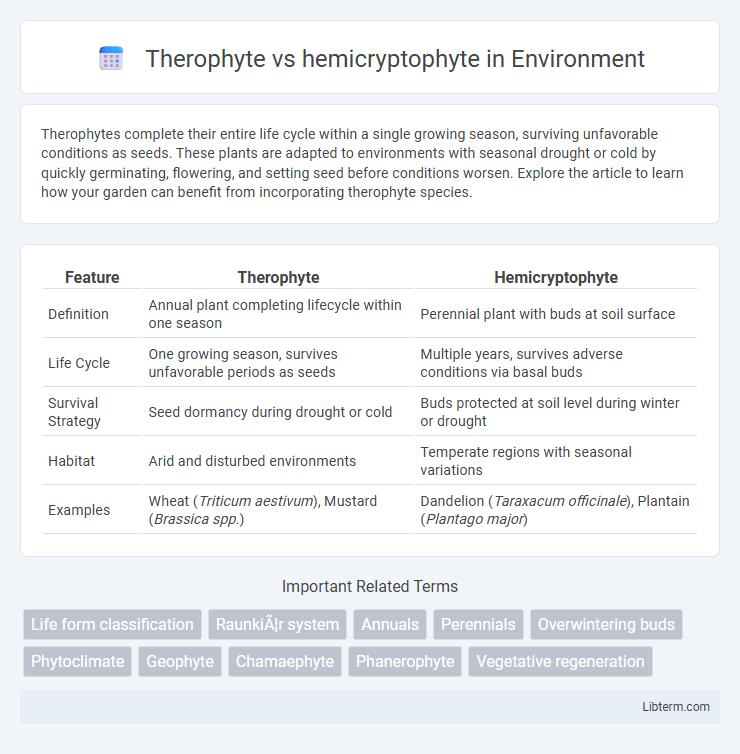Therophytes complete their entire life cycle within a single growing season, surviving unfavorable conditions as seeds. These plants are adapted to environments with seasonal drought or cold by quickly germinating, flowering, and setting seed before conditions worsen. Explore the article to learn how your garden can benefit from incorporating therophyte species.
Table of Comparison
| Feature | Therophyte | Hemicryptophyte |
|---|---|---|
| Definition | Annual plant completing lifecycle within one season | Perennial plant with buds at soil surface |
| Life Cycle | One growing season, survives unfavorable periods as seeds | Multiple years, survives adverse conditions via basal buds |
| Survival Strategy | Seed dormancy during drought or cold | Buds protected at soil level during winter or drought |
| Habitat | Arid and disturbed environments | Temperate regions with seasonal variations |
| Examples | Wheat (Triticum aestivum), Mustard (Brassica spp.) | Dandelion (Taraxacum officinale), Plantain (Plantago major) |
Introduction to Plant Life Forms
Therophytes are annual plants that complete their life cycle rapidly, surviving unfavorable seasons through seeds, whereas hemicryptophytes are perennial plants with buds situated at soil surface level, allowing them to endure adverse conditions. Both life forms represent adaptive strategies in plant ecology, with therophytes thriving in environments with seasonal droughts or disturbances and hemicryptophytes dominating temperate habitats subject to cold winters. Understanding these plant life forms aids in studying vegetation dynamics, ecological succession, and biodiversity patterns.
Defining Therophytes: Key Characteristics
Therophytes are annual plants that complete their entire life cycle--from germination to seed production--within a single growing season, often thriving in environments with unpredictable or harsh conditions. These plants survive unfavorable periods exclusively as seeds, lacking persistent vegetative structures above ground, which differentiates them from hemicryptophytes that maintain perennating buds at soil level. Key characteristics of therophytes include rapid growth, high seed production, and adaptation to disturbed or arid habitats, making them vital for ecological succession and soil stabilization.
Understanding Hemicryptophytes: Unique Traits
Hemicryptophytes are perennial plants characterized by their overwintering buds located at or just below the soil surface, enabling survival in harsh climates. Unlike therophytes, which complete their life cycle within a single season and survive unfavorable conditions as seeds, hemicryptophytes maintain persistent underground structures to regenerate annually. This unique adaptation allows hemicryptophytes to thrive in temperate environments with seasonal variations.
Ecological Roles of Therophytes
Therophytes, as annual plants completing their life cycle rapidly, play crucial ecological roles in colonizing disturbed or ephemeral habitats by quickly exploiting available resources and minimizing competition. Their seed dormancy and germination strategies ensure population persistence under fluctuating environmental conditions, contributing to ecosystem resilience and early successional stages. Unlike hemicryptophytes, which survive unfavorable seasons through perennating buds at the soil surface, therophytes rely solely on seed banks for regeneration, influencing soil seed dynamics and nutrient cycling.
Hemicryptophyte Adaptations in Different Environments
Hemicryptophytes possess perennating buds at soil level, allowing survival through adverse conditions such as cold winters or droughts by protecting meristematic tissues underground. Their adaptations include the development of dense leaf rosettes and hairy coverings to reduce water loss and withstand frost in temperate climates. In arid environments, hemicryptophytes often exhibit deep root systems to access water reserves, enabling persistence where moisture is limited.
Life Cycle Differences: Therophytes vs Hemicryptophytes
Therophytes complete their entire life cycle within a single growing season, germinating, flowering, and setting seed before dying as annual plants. Hemicryptophytes survive unfavorable seasons through perennating buds at or just below the soil surface, allowing them to regrow year after year as perennial plants. The key life cycle difference lies in the annual vs. perennial strategy, with therophytes relying on seed production for regeneration and hemicryptophytes enduring environmental stresses through underground or surface-level buds.
Distribution Patterns Across Ecosystems
Therophytes predominantly dominate arid and semi-arid ecosystems due to their ability to complete their life cycle rapidly during favorable conditions, ensuring survival through seed dormancy. Hemicryptophytes are more prevalent in temperate and alpine regions where their perennating buds at soil surface protect them from harsh winters and facilitate regrowth. The distribution of these life forms reflects adaptation to specific climatic stresses and resource availability across diverse biomes.
Response to Climate and Environmental Stress
Therophytes, as annual plants completing their life cycle during favorable seasons, exhibit high resilience to drought and temperature extremes by surviving as seeds during adverse conditions. Hemicryptophytes, with perennating buds at soil surface level, adapt to cold climates and periodic stress by resprouting from protected meristems after damage. Both strategies enable survival in variable environments, but therophytes emphasize rapid reproduction under brief optimal periods, while hemicryptophytes endure prolonged unfavorable conditions through structural persistence.
Therophytes and Hemicryptophytes in Agriculture
Therophytes, as annual plants completing their life cycle within a single growing season, are crucial in agriculture for crop rotation and soil conservation, especially in arid and semiarid regions where they prevent soil erosion through rapid germination and growth. Hemicryptophytes, with perennating buds at soil surface level, contribute to sustainable agriculture by enhancing soil structure and organic matter through their perennial root systems and ability to survive adverse conditions. Understanding the role of Therophytes and Hemicryptophytes in crop systems aids in optimizing biodiversity, improving soil fertility, and adapting farming practices to climate variability.
Conclusion: Comparative Significance in Vegetation Dynamics
Therophytes, as annual plants completing their life cycle quickly, dominate in environments with pronounced seasonal variability or frequent disturbances, ensuring rapid regeneration and colonization. Hemicryptophytes, with their perennating buds at soil level, play a crucial role in stable or temperate ecosystems by contributing to long-term vegetation persistence and resilience. The comparative significance lies in their complementary strategies: therophytes thrive in dynamic, transient habitats, while hemicryptophytes support vegetation stability and succession in less disturbed environments.
Therophyte Infographic

 libterm.com
libterm.com